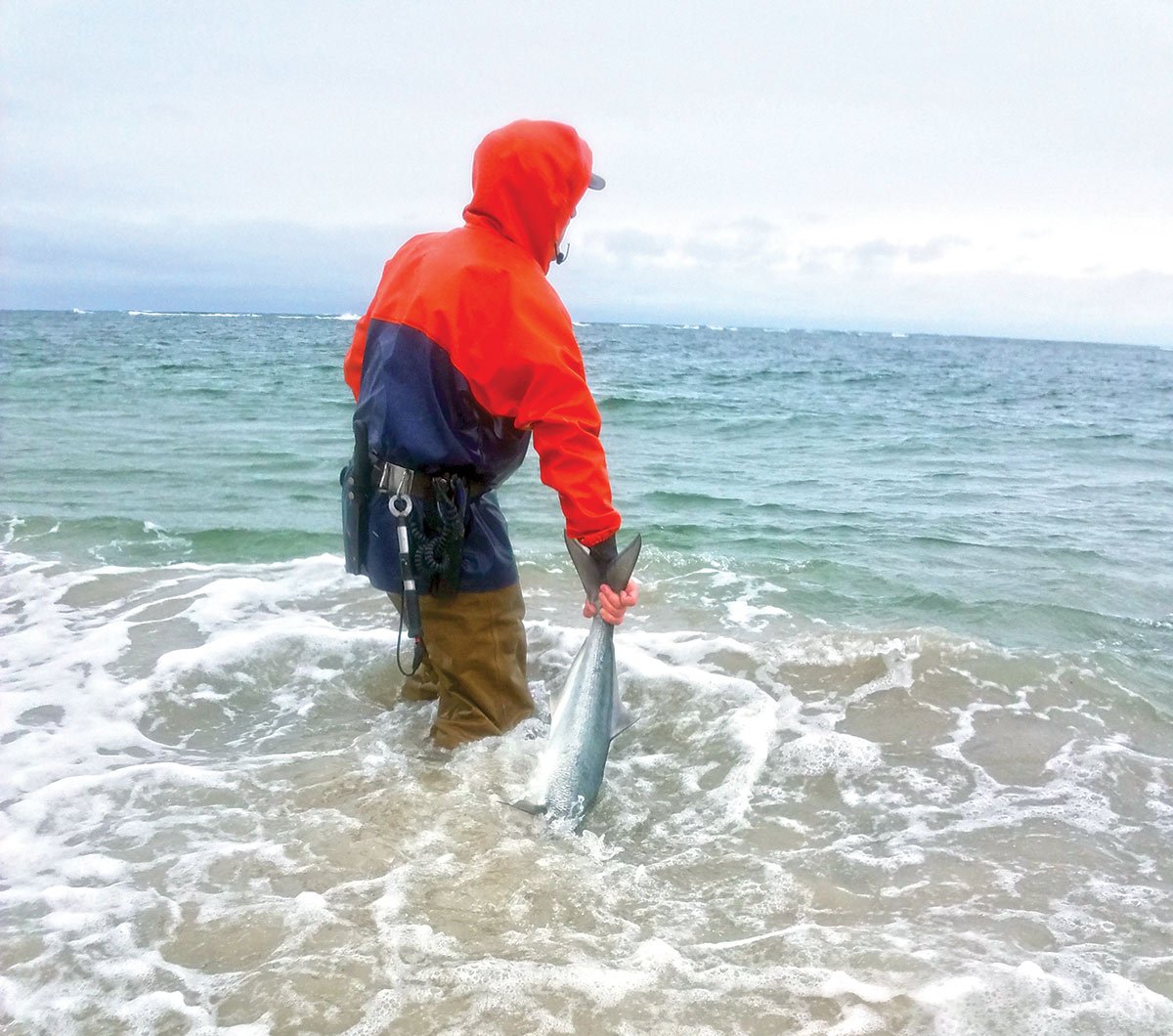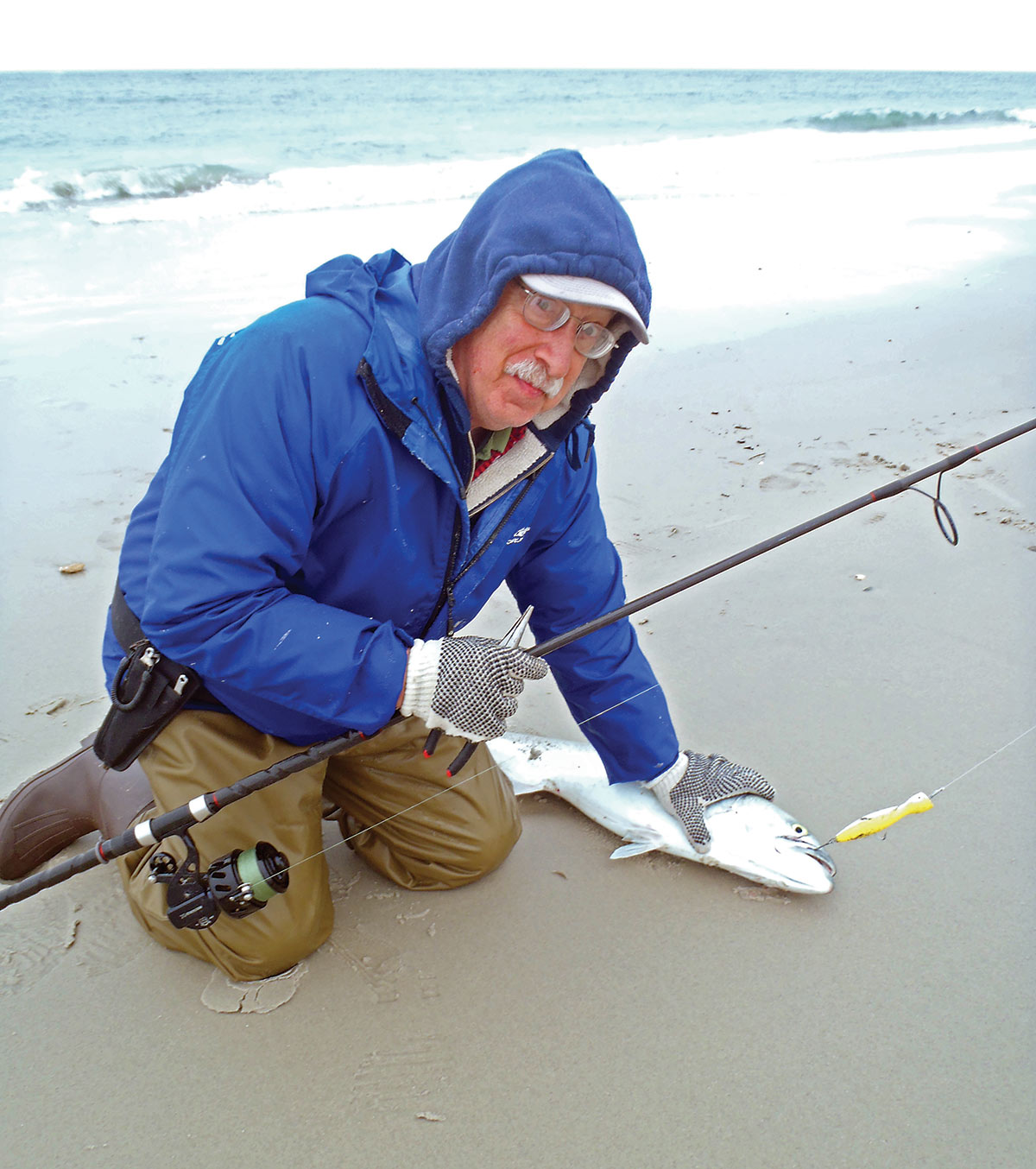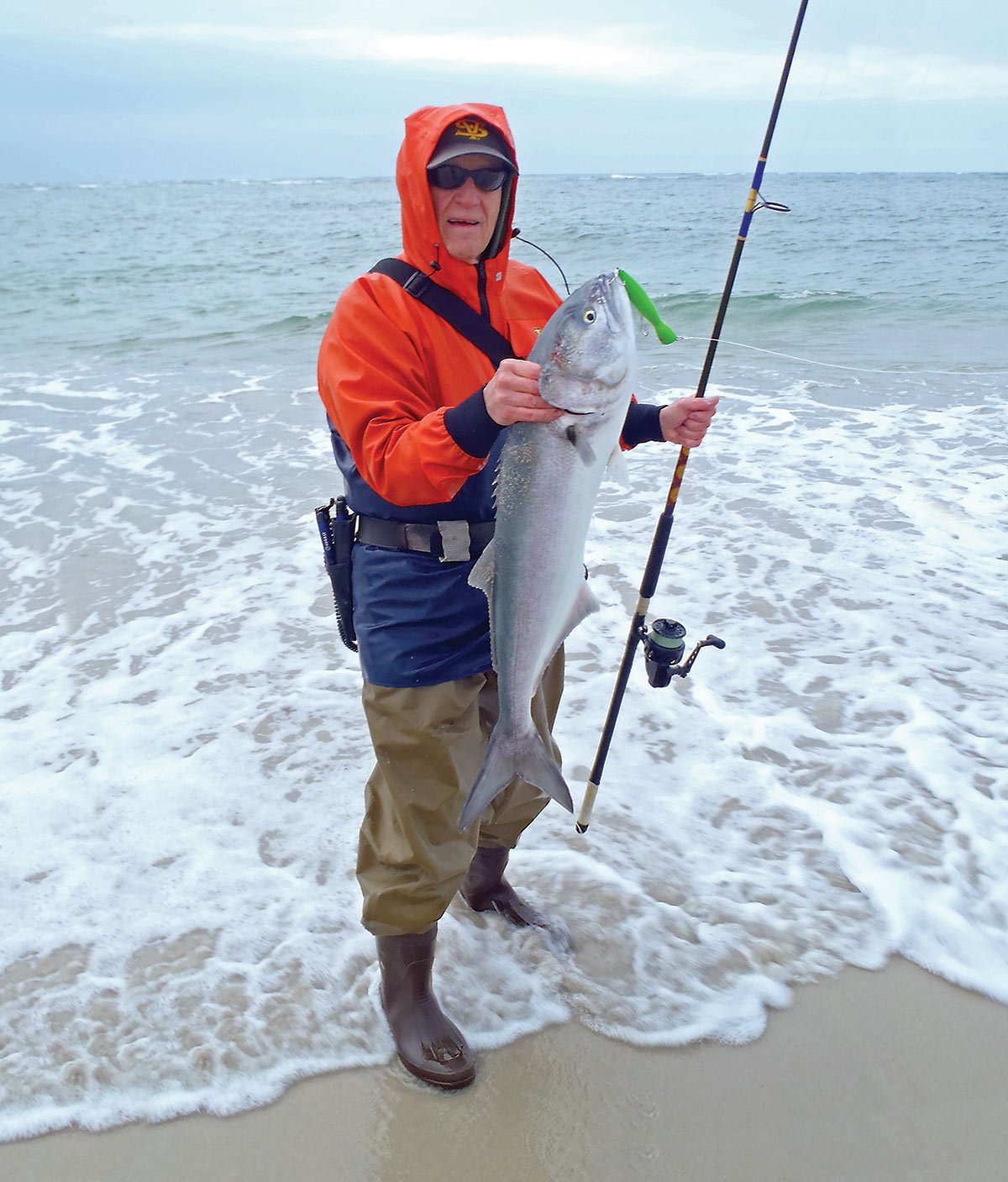
Water temperature, wind direction and tides are key factors in getting the most out of the spring bluefish run.
I’m guessing that all surf anglers who enjoy tangling with out-sized bluefish are feeling the blues now-a-days; I know I am. For me and many others the no-give-up attitude of teen bluefish is hard to beat, but data from fisheries managers say that the bluefish population is down by 50 percent since 1981. If you have trouble handling the importance of that percentage, allow me to explain how this decline impacts us, and which of us is impacted the most.
Bluefish are pelagic fish. That is, fish of the open ocean compared to fish like striped bass that are coastal ocean fish. Because of this, big bluefish prefer to remain well offshore where the tunas and billfish play, if they can. A logical question is, how come we enjoyed several decades of big schools of big blues roaming the beaches? The answer is: there were about 20 consecutive massive year classes from the 1950s into the 1970s. Massive consecutive year classes lead to huge schools of big blues. Eventually, there were so many adults they couldn’t all feed effectively in the open ocean. Feeding and space competition forced some massive schools to split off and move inshore in search of better feeding opportunities. They moved into the estuaries to feed on adult bunker, and they moved along the beaches in the fall, too. Those multiple massive year classes were followed by mostly poor to fair year classes and no massive ones. At that point the rate at which adult fish were removed from the population; through harvest, disease, predation, and old age, exceeded recruitment (spawning success). Thus, the number and size of adult bluefish schools shrunk and much less competition allowed more of them to remain away from the shallows. Last year was perhaps the worst year for big bluefish in memory. Long Island Sound boat anglers saw either few or none all, and of course except for two weeks of okay blue fishing in May, surf anglers caught few, too. Clearly, the Atlantic States Marine Fisheries Commission (ASFMC) that is charged with managing bluefish, must begin to take this decline very seriously. Okay, that’s the background, so let’s move on.
Our Innings
Of course, in surf fishing we refer to the hope that we will have a few good innings, and some years there are more and others less. When it comes to big blues, the month of May seems to be one of our innings. That raises the question of how can we maximize this opportunity. Getting the most from our efforts seems to be much more important now since the population has shrunk so drastically. Surf anglers once enjoyed four to five weeks of excellent May bluefish action in and near the South Shore inlets, but the length of the run has become shorter and shorter. The average size of the blues has also gotten smaller in recent years, although there are still some 16- to 18-pound fish caught. Finally, whereas in years past, there were frequent good catches, in 2018 they were sporadic. We can cry in our beer, or speak out loudly about the need for more conservation, as well as pay detailed attention to a list of success-determining factors. Maybe, just maybe, some of us can do our part by leaving the coolers home and simply keep one for the table.
Key Factors

The key water temperature for the arrival of big blues is 48 degrees. Since fickle spring weather has its ups and downs, we can’t count on a specific arrival day. I search the computer for surf temperatures every day waiting for the magic number. However, even when water the temperature along the beaches and inlets is in the low to mid-40s, by May 1 post-spawn blues won’t be far away. As close as 1 mile offshore, temps may be around 50 degrees, and one or two days of warm weather will raise temps in the shallows. If the fish are offshore in 50-degree water but the shore line is 46 degrees, the blues will remain there. A north wind for a few days will likely maintain that imbalance by pushing warm surface water to sea and sucking cold bottom water inshore. However, a south wind for a few days will push warmer water towards the beach, and the blues may follow.
Wind is always an important factor for success in surf fishing because it can have a profound influence on current strengths, bait movements, whether or not the surf zone is fishable, and water temperatures, too. Wind affects fishability, and even more so in the spring. There is more seaweed in spring, and onshore winds will raise it off the bottom as well as push weed exiting the inlets onto the beach. There is also the tendency for strong winds to muddy the water and sometimes bad enough to cause bait to move deep into the bay or further offshore. Wind can also either retard or accelerate inlet currents and that in turn will affect bait movements and fishing success. Strong south and southwest winds will slow currents in our inlets, while north, northwest, and to a lesser extent northeast winds typically accelerate currents. Calm seas will allow bait to swim more freely and find out-of-the-way places to hide from predators, while onshore winds create turbulence and current that forces bait into more vulnerable areas.
The Baitfish Factor
Obviously, if there is no bait, the blues will quickly depart for New England where large sand eels, herring, mackerel, and other species always seem to be abundant. An immediate departure in May is rare. Typically, although you may not always see them, our inlets have adult bunker schools, sand eels, squid, shad, and spawning adult mullet in varying abundance. If there’s lots of bait it will hold the bluefish. However, it’s important to understand that fishing strategies will change depending on the dominant bait. That is, if there are plenty of adult bunker around, fishing with large poppers and pencils is probably a good strategy. However, if large bait is scarce but sand eels and squid are abundant, a switch to sub-surface lures such as bucktails with pork rind and large flat-surfaced tins will probably be better choices. Anglers should be able to get a hint about the bait situation based upon what the bluefish spit up, what they chase out of the water, the smell coming off the water, and word of mouth.
Tides
Tides are always important, but never more so than in the spring. First, it’s more likely to be windy in spring than summer or early fall, and the wind will push against or pull the water forward affecting the height of high tide as well as how low the tide will be. Tidal range in turn affects the speed of the current, and all of this affects where the bait will be and hence the fish. I like to compare all factors against normal expectations of tide, wind, current, etc., so I can analyze possible positive or negative impacts on fishing.
Tides also influence spring weeds. A big tidal range and strong currents will dump weed out of shallow areas and keep it suspended in the water column. Inversely, small ranges and slower currents may allow weeds to settle out away from the beach. In recent years, slip-gut has been the bane of inlet anglers, but is less of a nuisance when currents are slowest.
Gearing Up

Although in the last few decades I’ve moved progressively more and more towards light tackle fishing thanks to technological advances resulting in better gear, the May bluefish run needs a little muscle. First, big blues are tough critters and although you can land them on light gear it will take longer, making successful release more difficult. Second, light gear doesn’t cast as far as heavier tackle and often distance is crucial. Third, any onshore wind hinders casting significantly. Finally, casting heavy lures; big poppers, big bucktails, and large metal lures is difficult if not impossible.
I prefer a 9-foot medium power rod with good flex near the tip. There’s nothing wrong with an 11-foot rod, but my 9-footer works fine. I pair the rod with a VS 200 spooled with 20-pound test braided line for the 9-foot rod, and when I use my 11-foot rod I add a VS 250 with 20-pound test braid. There’s plenty of casting distance and fighting power in the 9-footer, and good fun, too.
When I was young, similar to young bucks in the surf today, I toted a plug bag around that was more like a suitcase than a bag. I tried to carry every lure style, size, and color because I didn’t want to be unprepared. As I’ve aged, the weight of the suitcase became too much for my neck, back, and shoulders. As my bag shrunk, the number of lures I carried diminished too. This process of diminishment caused me to realize that I didn’t need all those lures in so many sizes and colors. Today, my bag is small and my lure selection is too. For May blues I carry two or three 2-3/8-ounce Super Strike Little Neck Poppers, one or two 2- to 3-ounce pencil poppers, seven bucktails from 1 to 2 ounces, and several Charlie Graves metal lures, usually D-5 and J-7 models. I keep the colors super simple: white bucktails, chrome tins, and white poppers and pencil poppers. I admit, sometimes my poppers have white bellies and another color on top, but the white theme dominates.
Angling Strategies
Allow me to point out that the temperament of May blues is aggressive, rendering the need for fancy lure styles and colors irrelevant. These adult fish have just come off the spawn at the western edge of the Gulf Stream. Spawning (when they do not eat), consumes a lot of energy that leaves them very, very hungry. The trick isn’t fooling them into striking; the trick, especially with depleted stocks, is to find them. Before the decline of bluefish reached the tipping point two years ago, I would pick a spot and stay there while school after school of big blues rumbled by. Last year, a spot might have fish one day but then be empty for days. Therefore, I bounced around a lot more last year, and I expect I’ll do the same this year.
To summarize my strategy, watch ocean water temperatures on a daily basis, looking for the magic number of 48 degrees. Keep track of the wind forecast and select a spot based on that prediction and your experience, to determine the best possible areas to fish. Fish outgoing tides early in May and switch to incoming later in the month to improve the odds of success. Avoid using light tackle because blues are mean and spring weather can often be a hindrance to casting heavy lures. Blues are hungry after the spawn so keep lure choices simple. Try to combine these factors in such a manner as to improve your chances of catching a few big blues, and remember that the population is down 50 percent, so I urge you to release as many blues as you can in order to maximize the chance the population will rebuild.



